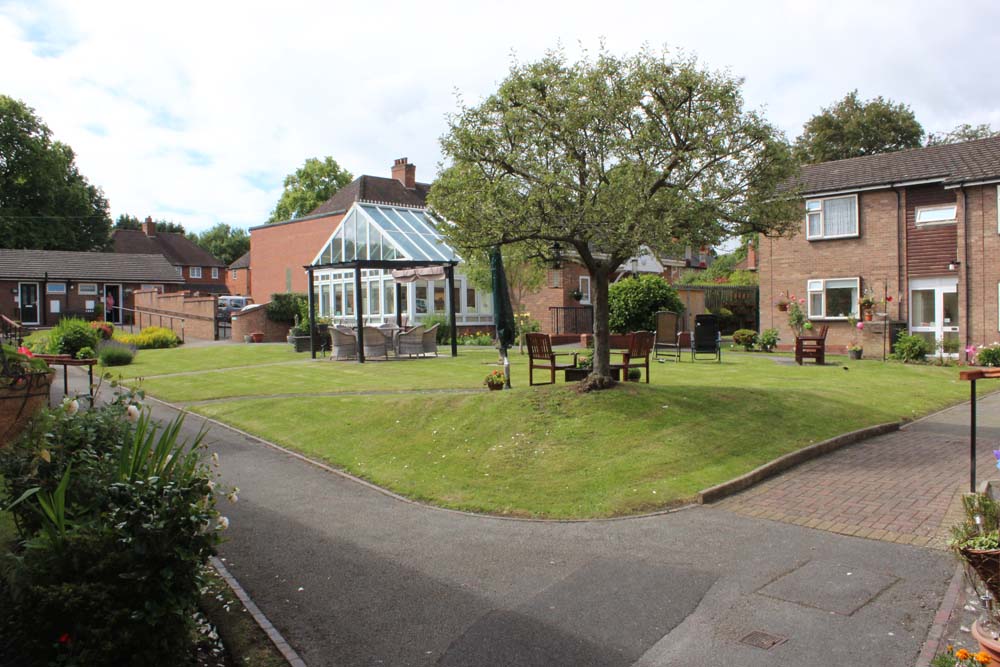
James Lloyd Almshouse Trust complex is set in the idyllic Bournville Village Trust, surrounded by the properties constructed by the Cadbury family.
Located on a tree lined road within the residential part of Bournville, the complex is a hidden little gem of tranquillity which offers sheltered accommodation for single ladies aged, on entry, 55 to 80.
James Lloyd Almshouse Trust is a charitable organisation, governed by a board. The trustees have a wealth of knowledge from their professional backgrounds and volunteer their time to ensure the trust is well governed.
The trust is a member of The Almshouse Association who represent 1600 independent almshouses and some 35,000 residents.
The trust moved to Bournville in 1972 in purpose built buildings and has regular maintenance and updates keeping it current.
History of the Trust
Elmira Lloyd founded the James Lloyd Trust, this was established from the original deeds. The Deed tells us James and Elmira Lloyd lived in Showell Green, which today is in Birmingham but, in the 1860s, was part of Worcestershire.
Following James’ death, in 1865, Elmira moved to Southfield House, Malvern and, in memory of her late husband, she decided to create an almshouse for needy single women, in Birmingham. She purchased several pieces of land, for investment purposes, most of which were built on and, in August 1866, acquired a little under half an acre in Hicks Street, Highgate, which no longer exists.
The James Lloyd Trust was created on 12th October 1869, and the construction of the almshouses quickly followed. In addition to the land, various other buildings were included. Elmira also gave £1000 as investment placed in shares in the London & North Western Railway Company and paid for the construction of the almshouses.
In Belgrave Road, Balsall Heath, the original almshouse development consisted of 12 four-roomed properties – each designed to accommodate two women – plus one four-roomed house, to be occupied by the Superintendent. There were also some outbuildings; presumably toilets, and a wash house.
Elmira charged no rent; on the contrary, she gave each occupant two shillings (20 pence) per week, and the Superintendent received four shillings per week – though the title ‘Superintendent’ was quickly changed to ‘Matron’.
The total number of residents was 25, and their selection is stipulated in the original Deed, which stated “residents must be a spinster or widow, over 60 years of age.” ‘Respectable’ is probably the term, but this is not used. Nor was it intended to take the very lowest in society.
Fairly standard Victorian values applied; “Preference shall be given to women who shall not be of the pauper class, nor wholly destitute but who, through misfortune or infirmity, are unable to earn a livelihood, or to subsist without charitable aid.”
The Deed also stated the almswomen can have any religious creed, but most certainly not the Roman Catholic faith. This is a slight twist on the rules which applied until relatively recently.
The original ‘house rules’ are reproduced below. Basically, if you did not create a nuisance or have an alcohol issue, you were there for life. The residents effectively occupied their homes under a licence, but were actually given the rather quaint title of “Tenants of Sufferance”.
The selection of Trustees is interesting; seven in total, three being ex-officio by virtue of their position.
Original Trustees
Elmira Lloyd Southfield House, Malvern
Thomas Lloyd The Priory, Warwick
Sampson Samuel Lloyd Moor Hall, Sutton Coldfield
George Braithwaite Lloyd Edgbaston
Samuel Lloyd The Farm, Bordesley, Birmingham
Ex-Officio
The Revd. William Wilkinson – Rector of the Parish of St. Martin’s, in Birmingham.
The Hon. & Revd. Grantham Munton Yorke – Rector of St. Philip’s, in Birmingham.
The Revd. William Bradshaw Benison – Vicar of St. Paul’s Church, Balsall Heath, Nr. Birmingham.
The Deed also includes details of how the Trust could invest money, and set aside £25 per year for repairs and painting of the properties. The first change of Deed is also recorded, dated 21st May, 1889. A further £1000 was invested in the same railway company, and two of the ex-officio Trustees, were replaced.
Following the death of the Revd. Yorke, Henry Bond Bowlby became Rector of St. Philips and the Revd. Charles Chapman Murray-Browne replaced the Revd. Benison at St. Paul’s.
In 1928 the income from rents was about £160 and from stock £70. Part of the property was sold in 1938 for £610 and a sum of £400 of accumulated surplus income invested at the same time. The income was being fully expended on the maintenance of the almshouse in 1957.
